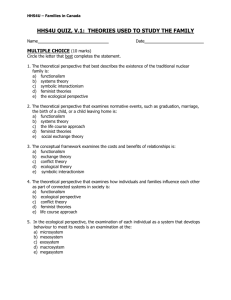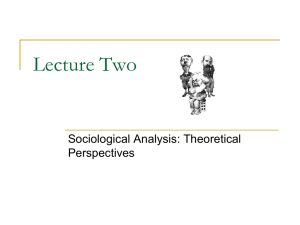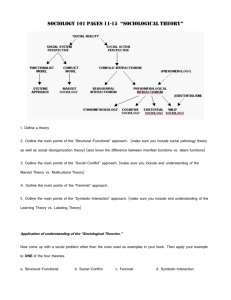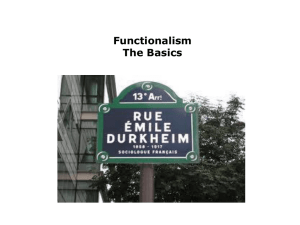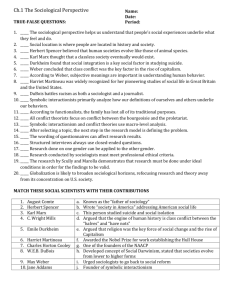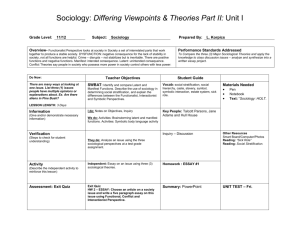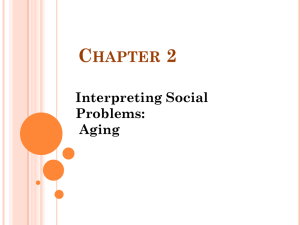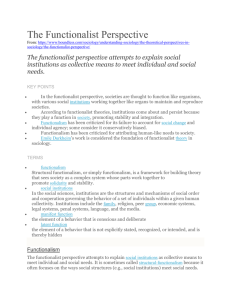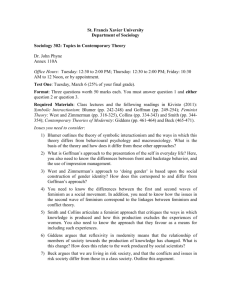HandoutNo2SocialProblems
advertisement
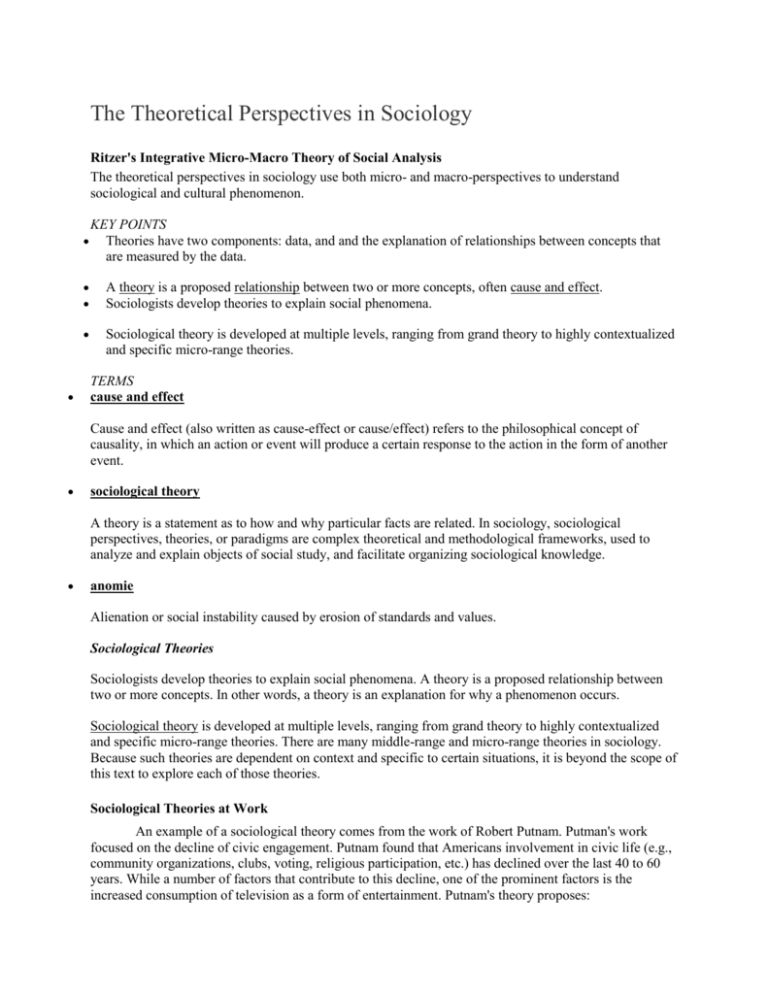
The Theoretical Perspectives in Sociology Ritzer's Integrative Micro-Macro Theory of Social Analysis The theoretical perspectives in sociology use both micro- and macro-perspectives to understand sociological and cultural phenomenon. KEY POINTS Theories have two components: data, and and the explanation of relationships between concepts that are measured by the data. A theory is a proposed relationship between two or more concepts, often cause and effect. Sociologists develop theories to explain social phenomena. Sociological theory is developed at multiple levels, ranging from grand theory to highly contextualized and specific micro-range theories. TERMS cause and effect Cause and effect (also written as cause-effect or cause/effect) refers to the philosophical concept of causality, in which an action or event will produce a certain response to the action in the form of another event. sociological theory A theory is a statement as to how and why particular facts are related. In sociology, sociological perspectives, theories, or paradigms are complex theoretical and methodological frameworks, used to analyze and explain objects of social study, and facilitate organizing sociological knowledge. anomie Alienation or social instability caused by erosion of standards and values. Sociological Theories Sociologists develop theories to explain social phenomena. A theory is a proposed relationship between two or more concepts. In other words, a theory is an explanation for why a phenomenon occurs. Sociological theory is developed at multiple levels, ranging from grand theory to highly contextualized and specific micro-range theories. There are many middle-range and micro-range theories in sociology. Because such theories are dependent on context and specific to certain situations, it is beyond the scope of this text to explore each of those theories. Sociological Theories at Work An example of a sociological theory comes from the work of Robert Putnam. Putman's work focused on the decline of civic engagement. Putnam found that Americans involvement in civic life (e.g., community organizations, clubs, voting, religious participation, etc.) has declined over the last 40 to 60 years. While a number of factors that contribute to this decline, one of the prominent factors is the increased consumption of television as a form of entertainment. Putnam's theory proposes: The more television people watch, the lower their involvement in civic life will be. This element of Putnam's theory clearly illustrates the basic purpose of sociological theory. Putnam's theory proposes a relationship between two or more concepts. In this case, the concepts are civic engagement and television watching. This is an inverse relationship - as one goes up, the other goes down; it is also an explanation of one phenomenon with another: part of the reason for the decline in civic engagement over the last several decades is because people are watching more television. In short, Putnam's theory clearly encapsulates the key ideas of a sociological theory. Importance of Theory Theory is the connective tissue that bridges the connection between raw data and critical thought. In the theory above, the data showed that that civic engagement has declined and TV watching has increased. Data alone are not particularly informative. If Putnam had not proposed a relationship between the two elements of social life, we may not have realized that television viewing does, in fact, reduce people's desire to, and time for participating in civic life. In order to understand the social world around us, it is necessary to employ theory to draw the connections between seemingly disparate concepts. Another example of sociological theorizing illustrates this point. In his now classic work,Suicide, Emile Durkheim was interested in explaining a social phenomenon, suicide, and employed both data and theory to offer an explanation. By aggregating data for large groups of people in Europe, Durkheim was able to discern patterns in suicide rates and connect those patterns with another concept (or variable), religious affiliation. Durkheim found that Protestants were more likely than Catholics to commit suicide. At this point, Durkheim's analysis was still in the data stage; he had not proposed an explanation for the different suicide rates of the two groups. When Durkheim introduced the ideas of anomie and social solidarity, he began to explain the difference in suicide rates. Durkheim argued that the looser social ties found in Protestant religions lead to weaker social cohesion and reduced social solidarity. The higher suicide rates were the result of weakening social bonds among Protestants. While Durkheim's findings have since been criticized, his study is a classic example of the use of theory to explain the relationship between two concepts. Durkheim's work also illustrates the importance of theory: without theories to explain the relationship between concepts, we would not be able to understand cause and effect relationships in social life. The discovery of the cause and effect relationship is the major component of the sociological theory. Theories: Are Some Better than Others? There are many theories in sociology, but there are several broad theoretical perspectives that are prominent in the field. These theories are prominent because they are quite good at explaining social life. They are not without their problems, but these theories remain widely used and cited precisely because they have withstood a great deal of criticism. You might be inclined to ask, "Which theories are the best?" As is often the case in sociology, just because things are different doesn't mean one is better than another. In fact, it is probably more useful and informative to view theories as complementary. One theory may explain one element of society better than another. Or, both may be useful for explaining social life. In short, all of the theories are correct in the sense that they offer compelling explanations for social phenomena. The Functionalist Perspective The functionalist perspective attempts to explain social institutions as collective means to meet individual and social needs. 1. Émile Durkheim Emile Durkheim's work is considered the foundation of functionalist theory in sociology. KEY POINTS In the functionalist perspective, societies are thought to function like organisms, with various social institutions working together like organs to maintain and reproduce societies. According to functionalist theories, institutions come about and persist because they play a function in society, promoting stability and integration. Functionalism has been criticized for its failure to account for social change and individual agency; some consider it conservatively biased. Functionalism has been criticized for attributing human-like needs to society. Emile Durkheim's work is considered the foundation of functionalist theory in sociology. TERMS functionalism Structural functionalism, or simply functionalism, is a framework for building theory that sees society as a complex system whose parts work together to promote solidarity and stability. social institutions In the social sciences, institutions are the structures and mechanisms of social order and cooperation governing the behavior of a set of individuals within a given human collectivity. Institutions include the family, religion, peer group, economic systems, legal systems, penal systems, language, and the media. manifest function the element of a behavior that is conscious and deliberate latent function the element of a behavior that is not explicitly stated, recognized, or intended, and is thereby hidden Functionalism The functionalist perspective attempts to explain social institutions as collective means to meet individual and social needs. It is sometimes called structural-functionalismbecause it often focuses on the ways social structures (e.g., social institutions) meet social needs. Functionalism draws its inspiration from the ideas of Emile Durkheim. Durkheim was concerned with the question of how societies maintain internal stability and survive over time. He sought to explain social stability through the concept of solidarity, and differentiated between the mechanical solidarity of primitive societies and the organic solidarity of complex modern societies. According to Durkheim, more primitive or traditional societies were held together by mechanical solidarity; members of society lived in relatively small and undifferentiated groups, where they shared strong family ties and performed similar daily tasks. Such societies were held together by shared values and common symbols. By contrast, he observed that, in modern societies, traditional family bonds are weaker; modern societies also exhibit a complex division of labor, where members perform very different daily tasks. Durkheim argued that modern industrial society would destroy the traditional mechanical solidarity that held primitive societies together. Modern societies however, do not fall apart. Instead, modern societies rely on organic solidarity; because of the extensive division of labor, members of society are forced to interact and exchange with one another to provide the things they need. The functionalist perspective continues to try and explain how societies maintained the stability and internal cohesion necessary to ensure their continued existence over time. In the functionalist perspective, societies are thought to function like organisms, with various social institutions working together like organs to maintain and reproduce them. The various parts of society are assumed to work together naturally and automatically to maintain overall social equilibrium. Because social institutions are functionally integrated to form a stable system, a change in one institution will precipitate a change in other institutions. Dysfunctional institutions, which do not contribute to the overall maintenance of a society, will cease to exist. In the 1950s, Robert Merton elaborated the functionalist perspective by proposing a distinction between manifest and latent functions. Manifest functions are the intended functions of an institution or a phenomenon in a social system. Latent functions are its unintended functions. Latent functions may be undesirable, but unintended consequences, or manifestly dysfunctional institutions may have latent functions that explain their persistence. For example, crime seems difficult to explain from the functionalist perspective; it seems to play little role in maintaining social stability. Crime, however, may have the latent function of providing examples that demonstrate the boundaries of acceptable behavior and the function of these boundaries to maintain social norms. Social Institutions Functionalists analyze social institutions in terms of the function they play. In other words, to understand a component of society, one must ask, "What is the function of this institution? How does it contribute to social stability?" Thus, one can ask of education, "What is the function of education for society?" A complete answer would be quite complex and require a detailed analysis of the history of education, but one obvious answer is that education prepares individuals to enter the workforce and, therefore, maintains a functioning economy. By delineating the functions of elements of society, of the social structure, we can better understand social life. Criticism of Functionalism Functionalism has been criticized for downplaying the role of individual action, and for being unable to account for social change. In the functionalist perspective, society and its institutions are the primary units of analysis. Individuals are significant only in terms of their places within social systems (i.e., social status and position in patterns of social relations). Some critics also take issue with functionalism's tendency to attribute needs to society. They point out that, unlike human beings, society does not have needs; society is only alive in the sense that it is made up of living individuals. By downplaying the role of individuals, functionalism is less likely to recognize how individual actions may alter social institutions. Critics also argue that functionalism is unable to explain social change because it focuses so intently on social order and equilibrium in society. Following functionalist logic, if a social institution exists, it must serve a function. Institutions, however, change over time; some disappear and others come into being. The focus of functionalism on elements of social life in relation to their present function, and not their past functions, makes it difficult to use functionalism to explain why a function of some element of society might change, or how such change occurs. The Conflict Perspective Conflict theory sees society as a dynamic entity constantly undergoing change as a result of competition over scarce resources. Karl Marx Conflict theory derives from the ideas of Karl Marx. KEY POINTS Conflict theory sees social life as a competition, and focuses on the distribution of resources, power, and inequality. Unlike functionalist theory, conflict theory is better at explaining social change, and weaker at explaining social stability. Conflict theory has been critiqued for its inability to explain social stability and incremental change. Conflict theory derives from the ideas of Karl Marx. TERMS conflict theory A social science perspective that holds that stratification is dysfunctional and harmful in society, with inequality perpetuated because it benefits the rich and powerful at the expense of the poor. functionalism Structural functionalism, or simply functionalism, is a framework for building theory that sees society as a complex system whose parts work together to promote solidarity and stability. EXAMPLES A conflict theorist might ask, "Who benefits from the current higher educational system in the U.S.?" The answer, for a conflict theorist attuned to unequal distributions of wealth, is the wealthy. After all, higher education in the U.S. is not free. The educational system often screens out poorer individuals, not because they are unable to compete academically, but because they cannot afford to pay for their education. Because the poor are unable to obtain higher education, they are generally also unable to get higher paying jobs, and, thus, they remain poor. Such an arrangement translates into a vicious cycle of poverty. While a functionalist might say that the function of education is to educate the workforce, a conflict theorist might point out that it also has an element of conflict and inequality, favoring one group (the wealthy) over other groups (the poor). Thinking about education in this way helps illustrate why both functionalist and conflict theories are helpful in understanding how society works. The Conflict Perspective The conflict perspective, or conflict theory, derives from the ideas of Karl Marx, who believed society is a dynamic entity constantly undergoing change driven by class conflict. Whereas functionalism understands society as a complex system striving for equilibrium, the conflict perspective views social life as competition. According to the conflict perspective, society is made up of individuals competing for limited resources (e.g., money, leisure, sexual partners, etc.). Competition over scarce resources is at the heart of all social relationships. Competition, rather than consensus, is characteristic of human relationships. Broader social structures and organizations (e.g., religions, government, etc.) reflect the competition for resources and the inherent inequality competition entails; some people and organizations have more resources (i.e., power and influence), and use those resources to maintain their positions of power in society. C. Wright Mills is known as the founder of modern conflict theory. In his work, he believes social structures are created because of conflict between differing interests. People are then impacted by the creation of social structures, and the usual result is a differential of power between the "elite" and the "others". Examples of the "elite" would be government and large corporations. G. William Domhoff believes in a similar philosophy as Mills and has written about the "power elite of America". Sociologists who work from the conflict perspective study the distribution of resources, power, and inequality. When studying a social institution or phenomenon, they ask, "Who benefits from this element of society?" Conflict Theory and Change While functionalism emphasizes stability, conflict theory emphasizes change. According to the conflict perspective, society is constantly in conflict over resources, and that conflict drives social change. For example, conflict theorists might explain the civil rights movements of the 1960s by studying how activists challenged the racially unequal distribution of political power and economic resources. As in this example, conflict theorists generally see social change as abrupt, even revolutionary, rather than incremental. In the conflict perspective, change comes about through conflict between competing interests, not consensus or adaptation. Conflict theory, therefore, gives sociologists a framework for explaining social change, thereby addressing one of the problems with the functionalist perspective. Criticism of Conflict Theory Predictably, conflict theory has been criticized for its focus on change and neglect of social stability. Some critics acknowledge that societies are in a constant state of change, but point out that much of the change is minor or incremental, not revolutionary. For example, many modern capitalist states have avoided a communist revolution, and have instead instituted elaborate social service programs. Although conflict theorists often focus on social change, they have, in fact, also developed a theory to explain social stability. According to the conflict perspective, inequalities in power and reward are built into all social structures. Individuals and groups who benefit from any particular structure strive to see it maintained. For example, the wealthy may fight to maintain their privileged access to higher education by opposing measures that would broaden access, such as affirmative action or public funding. The Symbolic Interactionist Perspective Symbolic interactionism looks at individual and group meaning-making, focusing on human action instead of large-scale social structures. The Looking Glass Self This drawing depicts the looking-glass self. The person at the front of the image is looking into four mirrors, each of which reflects someone else's image of himself. KEY POINTS Symbolic interactionism has roots in phenomenology, which emphasizes the subjective meaning of reality. Symbolic interactionism proposes a social theory of the self, or a looking glass self. Symbolic interactionists study meaning and communication; they tend to usequalitative methods. Symbolic interactionism has been criticized for failing to take into account large-scale macro social structures and forces. TERMS phenomenology A philosophy based on the intuitive experience of phenomena, and on the premise that reality consists of objects and events as consciously perceived by conscious beings. behaviorism an approach to psychology focusing on behavior, denying any independent significance for mind, and assuming that behavior is determined by the environment role theory assumes that people are primarily conformists who try to achieve the norms that accompany their roles; group members check each individual’s performance to determine whether it conforms with that individual’s assigned norms, and apply sanctions for misbehavior in an attempt to ensure role performance. EXAMPLES A good example of the looking glass self is a person trying on clothes before going out with friends. Some people may not think much about how others will think about their clothing choices, but others can spend quite a bit of time considering what they are going to wear. While they are deciding, the dialogue taking place inside their mind is usually a dialogue between their "self" (that portion of theiridentity that calls itself "I") and that person's internalized understanding of their friends and society (a "generalized other"). An indicator of mature socialization is when an individual quite accurately predicts how other people think about him or her. Such an individual has incorporated the "social" into the "self." 1. Charles Cooley Cooley developed the idea of the looking glass self. Symbolic interactionism is a theoretical approach to understanding the relationship between humans and society. The basic notion of symbolic interactionism is that human action and interaction are understandable only through the exchange of meaningful communication or symbols. In this approach, humans are portrayed as acting, as opposed to being acted upon. The main principles of symbolic interactionism are: Human beings act toward things on the basis of the meanings that things have for them These meanings arise out of social interaction Social action results from a fitting together of individual lines of action This approach stands in contrast to the strict behaviorism of psychological theories prevalent at the time it was first formulated (the 1920s and 1930s). According to symbolic interactionism, humans are distinct from infrahumans (lower animals) because infrahumans simply respond to their environment (i.e., a stimulus evokes a response or stimulus ⇒ response), whereas humans have the ability to interrupt that process (i.e., stimulus ⇒ cognition ⇒ response). Additionally, infrahumans are unable to conceive of alternative responses to gestures. Humans, however, can. This understanding should not be taken to indicate that humans never behave in a strict stimulus ⇒ response fashion, but rather that humans have the capability of responding in a different way, and do so much of the time. This perspective is also rooted in phenomenological thought. According to symbolic interactionism, the objective world has no reality for humans; only subjectively defined objects have meaning. Meanings are not entities that are bestowed on humans and learned by habituation; instead, meanings can be altered through the creative capabilities of humans, and individuals may influence the many meanings that form their society. Human society, therefore, is a social product. The Looking Glass Self Neurological evidence, based on EEGs, supports the idea that humans have a "social brain," meaning, there are components of the human brain that govern social interaction. These parts of the brain begin developing in early childhood (the preschool years) and aid humans in understanding how other people think. In symbolic interactionism, this is known as "reflected appraisals" or "the looking glass self," and refers to our ability to think about how other people will think about us. In 1902, Charles Horton Cooley Figure 2 developed the social psychological concept of the looking glass self. The term was first used in his work, Human Nature and the Social Order. There are three main components of the looking glass self: We imagine how we must appear to others We imagine the judgment of that appearance We develop our self through the judgments of others Cooley clarified this concept in his writings, stating that society is an interweaving and interworking of mental selves. In hypothesizing the framework for the looking glass self, Cooley said, "the mind is mental" because "the human mind is social." As children, humans begin to define themselves within the context of their socializations. The child learns that the symbol of his/her crying will elicit a response from his/her parents, not only when they are in need of necessities, such as food, but also as a symbol to receive their attention. George Herbert Mead described self as "taking the role of the other," the premise for which the self is actualized. Through interaction with others, we begin to develop an identity about who we are, as well as empathy for others. This is the notion of, "Do unto others, as you would have them do unto you." In respect to this, Cooley said, "The thing that moves us to pride or shame is not the mere mechanical reflection of ourselves, but an imputed sentiment, the imagined effect of this reflection upon another's mind." It should be noted that symbolic interactionists advocate a particular methodology. Because they see meaning as the fundamental component of the interaction of human and society, studying human and social interaction requires an understanding of that meaning. Symbolic interactionists tend to employ more qualitative, rather than quantitative, methods in their research. The most significant limitation of the symbolic interactionist perspective relates to its primary contribution: it overlooks macro-social structures (e.g., norms, culture) as a result of focusing on micro-level interactions. Some symbolic interactionists, however, would counter that the incorporation of role theory into symbolic interactionism addresses this criticism. The Feminist Perspective Feminist theory is a conflict theory that studies gender, patriarchy, and the oppression of women 1. First-wave feminists fight for women's suffrage Over the years, feminist demands have changed. First-wave feminists fought for basic citizenship rights, such as the right to vote, while third wave feminists are concerned with more complex social movements, like post-structuralism. KEY POINTS Feminist theory has developed in three waves. The first wave focused on suffrageand political rights. The second focused on social inequality between the genders. The current, third wave emphasizes the concepts of globalization, postcolonialism, post-structuralism, and postmodernism. Third wave feminist theory critiques generalizations about sex and gender. Feminist critiques of heterosexism and is closely allied with queer theory and the work of Michel Foucault. Feminist theory also studies the intersections of sex, gender, sexuality, race, nationality, and economic status. Feminism may conflict with multiculturalism. While muticulturalism necessitates the tolerance of foreign cultural practices, some of those practices might maintain an oppression of women that feminists find essentially intolerable and unacceptable. TERMS multiculturalism A characteristic of a society that has many different ethnic or national cultures mingling freely. It can also refer to political or social policies which support or encourage such a coexistence. Important in this is the idea that cultural practices, no matter how unusual, should be tolerated as a measure of respect. poststructuralism an extension of structuralism influenced by the effort to deconstruct or challenge traditional categories postmodernism any style in art, architecture, literature, philosophy, etc., that reacts against an earlier modernist movement EXAMPLES When was the last time you walked into a toy store? Next time you do, pause to take a look at the shelves. Most toy stores use gendered displays to market different toys to boys and girls. The section targeting girls will often be bathed in pink, with dolls, model kitchens, fake makeup sets, and other toys focused on child rearing, domestic chores, or personal hygiene and beauty. The section targeting boys will often be filled with violent toys, guns, action figures, toy monsters and aliens. It may also have toy sets for building structures, models, and robots. No formal rules keep girls from shopping in the boys section or vice versa, but the gendered marketing nevertheless reinforces gender stereotypes. Feminism The feminist perspective has much in common with the conflict perspective. However, instead of focusing broadly on the unequal distribution of power and resources, feminist sociology studies power in its relation to gender. This topic is studied both within social structures at large and at the micro level of face-to-face interaction, the latter of which incorporates the methodology of symbolic interactionism (popularized by Erving Goffman). Feminist scholars study a range of topics, including sexual orientation, race, economic status, and nationality. However, at the core of feminist sociology is the idea that, in most societies, women have been systematically oppressed and that men have been historically dominant. This is referred to as patriarchy. Three Waves of Feminism Feminist thought has a rich history, which is categorized into three waves. At the turn of the century, the first wave of feminism focused on official, political inequalities and fought for women's suffrage. In the 1960s, second wave feminism, also known as the women's liberation movement, turned its attention to a broader range of inequalities, including those in the workplace, the family, and reproductive rights. Currently, a third wave of feminism is criticizing the fact that the first two waves of feminism were dominated by white women from advanced capitalist societies. This movement emphasizes diversity and change, and focuses on concepts such as globalization, postcolonialism, poststructuralism, and postmodernism. Contemporary feminist thought tends to dismiss essentializing generalizations about sex and gender (e.g., women are naturally more nurturing) and to emphasize the importance of intersections within identity (e.g., race and gender). The feminist perspective also recognizes that women who suffer from oppression due to race, in addition to the oppression they suffer for being women, may find themselves in a double bind. The relationship between feminism and race was largely overlooked until the second wave of feminists produced literature on the topic of black feminism. This topic has received much more attention from third wave scholars and activists. Feminism and Heterosexism The feminist perspective also criticizes exclusive understandings of sexuality, such as heterosexism. Heterosexism is a system of attitudes, bias, and discrimination that favor male-female sexuality and relationships. At one point, heterosexual marriage was the only lawful union between two people that was recognized and given full benefits in the United States. This situated homosexual couples at a disadvantage, and made them ineligible for many of the government or employer-provided benefits afforded heterosexual married couples. However, heterosexism can extend far beyond government validation, as it describes a set of paradigms and institutionalized beliefs that systematically disadvantage anyone who does not fit into a normative mold. Like racism, heterosexism can operate on an institutional level (e.g., through government) and at an individual level (i.e., in face-to-face interactions). Feminist critiques of heterosexism thus align with queer theory and the ideas of Michel Foucault, who studied the relationship between power and sexuality. Feminism and Multiculturalism Though the feminist perspective focuses on diversity and liberation, it has been accused of being incompatible with multiculturalist policy. Multiculturalism aims to allow distinct cultures to reside together, either as distinct enclaves within ostensively Western societies, or as separate societies with national borders. One possible consequence of multiculturalism is that certain religious or traditional practices, that might disadvantage or oppress women, might be tolerated on the grounds of cultural sensitivity. From the Feminist perspective, such practices are objectionable to human rights and ought to be criminalized on those grounds. However, from a multiculturalist perspective, such traditions must be respected even if they seem to directly violate ideas about freedom or liberty. Controversies about this have arisen with both arranged marriages and female genital mutilation.
